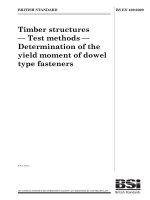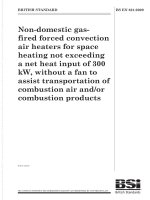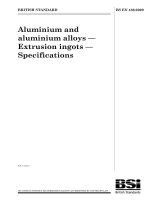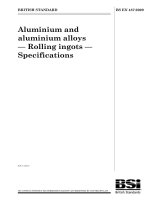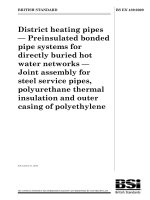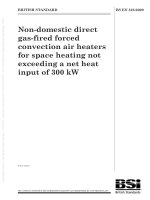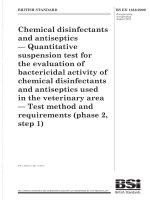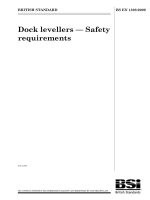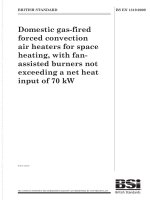Bsi bs en 00422 2009
Bạn đang xem bản rút gọn của tài liệu. Xem và tải ngay bản đầy đủ của tài liệu tại đây (310.87 KB, 28 trang )
BRITISH STANDARD
Plastics and rubber
machines — Blow
moulding machines —
Safety requirements
ICS 83.200
NO COPYING WITHOUT BSI PERMISSION EXCEPT AS PERMITTED BY COPYRIGHT LAW
BS EN 422:2009
BS EN 422:2009
National foreword
This British Standard is the UK implementation of EN 422:2009. It
supersedes BS EN 422:1996 which is withdrawn.
The UK participation in its preparation was entrusted to Technical
Committee MCE/3/2, Rubber and plastics machine - Safety.
A list of organizations represented on this committee can be obtained on
request to its secretary.
This publication does not purport to include all the necessary provisions
of a contract. Users are responsible for its correct application.
Compliance with a British Standard cannot confer immunity
from legal obligations.
This British Standard
was published under the
authority of the Standards
Policy and Strategy
Committee on 30 June
2009.
© BSI 2009
ISBN 978 0 580 60789 9
Amendments/corrigenda issued since publication
Date
Comments
BS EN 422:2009
EUROPEAN STANDARD
EN 422
NORME EUROPÉENNE
EUROPÄISCHE NORM
June 2009
ICS 83.200
Supersedes EN 422:1995
English Version
Plastics and rubber machines - Blow moulding machines Safety requirements
Machines pour les matières plastiques et le caoutchouc Machines de moulage par soufflage - Prescriptions de
sécurité
Kunststoff- und Gummimaschinen - Blasformmaschinen Sicherheitsanforderungen
This European Standard was approved by CEN on 13 May 2009.
CEN members are bound to comply with the CEN/CENELEC Internal Regulations which stipulate the conditions for giving this European
Standard the status of a national standard without any alteration. Up-to-date lists and bibliographical references concerning such national
standards may be obtained on application to the CEN Management Centre or to any CEN member.
This European Standard exists in three official versions (English, French, German). A version in any other language made by translation
under the responsibility of a CEN member into its own language and notified to the CEN Management Centre has the same status as the
official versions.
CEN members are the national standards bodies of Austria, Belgium, Bulgaria, Cyprus, Czech Republic, Denmark, Estonia, Finland,
France, Germany, Greece, Hungary, Iceland, Ireland, Italy, Latvia, Lithuania, Luxembourg, Malta, Netherlands, Norway, Poland, Portugal,
Romania, Slovakia, Slovenia, Spain, Sweden, Switzerland and United Kingdom.
EUROPEAN COMMITTEE FOR STANDARDIZATION
COMITÉ EUROPÉEN DE NORMALISATION
EUROPÄISCHES KOMITEE FÜR NORMUNG
Management Centre: Avenue Marnix 17, B-1000 Brussels
© 2009 CEN
All rights of exploitation in any form and by any means reserved
worldwide for CEN national Members.
Ref. No. EN 422:2009: E
BS EN 422:2009
EN 422:2009 (E)
Contents
Page
Foreword ..............................................................................................................................................................4
Introduction .........................................................................................................................................................5
1
Scope ......................................................................................................................................................6
2
Normative references ............................................................................................................................6
3
Terms and definitions ...........................................................................................................................7
4
4.1
4.2
4.3
4.3.1
4.3.2
4.4
List of significant hazards ....................................................................................................................8
General hazards .....................................................................................................................................8
Mechanical hazards related to power operated movements during production ......................... 10
Additional hazards associated with machines of specific design ................................................ 10
Machines allowing whole body access ............................................................................................ 10
Rotary machines ................................................................................................................................. 10
Additional hazards when using ancillary equipment ...................................................................... 10
5
5.1
5.1.1
5.1.2
5.1.3
5.1.4
5.1.5
5.1.6
5.1.7
5.1.8
5.1.9
5.1.10
5.1.11
5.1.12
5.2
5.2.1
5.2.2
5.3
5.3.1
5.3.2
5.4
Safety requirements and/or protective measures ........................................................................... 10
General ................................................................................................................................................. 10
Basic requirements............................................................................................................................. 10
Safety distances.................................................................................................................................. 10
Emergency stop .................................................................................................................................. 11
Fluid systems ...................................................................................................................................... 11
Safeguards .......................................................................................................................................... 11
Movements caused by gravity........................................................................................................... 12
Electrical hazards and hazards due to electromagnetic interference ........................................... 12
Thermal hazards ................................................................................................................................. 12
Hazards due to harmful substances ................................................................................................. 12
Fire hazards ......................................................................................................................................... 13
Hazards due to overpressure ............................................................................................................ 13
Mechanical hazards during setting ................................................................................................... 13
Mechanical hazards related to power operated movements during production ......................... 14
Basic requirements............................................................................................................................. 14
Additional requirements .................................................................................................................... 16
Additional hazards associated with machines of specific design ................................................ 17
Machines allowing whole body access ............................................................................................ 17
Rotary machines ................................................................................................................................. 17
Additional hazards when using ancillary equipment ...................................................................... 17
6
Verification of safety requirements and/or protective measures .................................................. 18
7
7.1
7.1.1
7.1.2
7.1.3
7.1.4
7.1.5
7.1.6
7.1.7
7.1.8
7.2
Information for use ............................................................................................................................. 20
Instruction handbook ......................................................................................................................... 20
General ................................................................................................................................................. 20
Safety-related components ................................................................................................................ 20
Emergency stop .................................................................................................................................. 20
Thermal hazards ................................................................................................................................. 20
Exhaust systems................................................................................................................................. 20
Fire hazard ........................................................................................................................................... 20
Setting .................................................................................................................................................. 20
Ancillary equipment ........................................................................................................................... 21
Marking ................................................................................................................................................ 21
Annex A (normative) Acknowledgement systems ........................................................................................ 22
A.1
Single acknowledgement system ..................................................................................................... 22
2
BS EN 422:2009
EN 422:2009 (E)
A.2
Double acknowledgement system ..................................................................................................... 22
Annex ZA (informative) Relationship between this European Standard and the Essential
Requirements of EU Directive 98/37/EC ............................................................................................ 23
Annex ZB (informative) Relationship between this European Standard and the Essential
Requirements of EU Directive 2006/42/EC ........................................................................................ 24
www.bzfxw.com
3
BS EN 422:2009
EN 422:2009 (E)
Foreword
This document (EN 422:2009) has been prepared by Technical Committee CEN/TC 145 “Plastics and rubber
machines”, the secretariat of which is held by UNI.
This European Standard shall be given the status of a national standard, either by publication of an identical
text or by endorsement, at the latest by December 2009, and conflicting national standards shall be withdrawn
at the latest by December 2009.
Attention is drawn to the possibility that some of the elements of this document may be the subject of patent
rights. CEN [and/or CENELEC] shall not be held responsible for identifying any or all such patent rights.
This document supersedes EN 422:1995.
This document has been prepared under a mandate given to CEN by the European Commission and the
European Free Trade Association, and supports essential requirements of EC Directive(s).
For relationship with EC Directive(s), see informative Annexes ZA, and ZB, which are integral parts of this
document.
According to the CEN/CENELEC Internal Regulations, the national standards organizations of the following
countries are bound to implement this European Standard: Austria, Belgium, Bulgaria, Cyprus, Czech
Republic, Denmark, Estonia, Finland, France, Germany, Greece, Hungary, Iceland, Ireland, Italy, Latvia,
Lithuania, Luxembourg, Malta, Netherlands, Norway, Poland, Portugal, Romania, Slovakia, Slovenia, Spain,
Sweden, Switzerland and the United Kingdom.
www.bzfxw.com
4
BS EN 422:2009
EN 422:2009 (E)
Introduction
This European Standard is a type C standard as defined in EN ISO 12100-1:2003.
The machinery concerned and the extent to which hazards, hazardous situations and hazardous events are
covered are indicated in the scope of this European Standard.
When provisions of this type C standard are different from those which are stated in type A or B standards, the
provisions of this type C standard take precedence over the provisions of the other standards for machines
that have been designed and built according to the provisions of this type C standard.
www.bzfxw.com
5
BS EN 422:2009
EN 422:2009 (E)
1
Scope
This European Standard covers essential health and safety requirements for the design of blow moulding
machines for the processing of plastics. The significant hazards inherent in blow moulding machines are listed in
Clause 4.
This European Standard does not cover dip blow moulding machines.
This European Standard does not cover hazards due to the use of fluorine or other toxic fluids.
The safety requirements for the interaction between blow moulding machines and ancillary equipment are
stipulated. The technical safety requirements for the design of this equipment are not covered.
This European Standard does not cover the requirements for the design of the exhaust system.
The European Standard does not cover noise hazards.
This European Standard is not applicable to blow moulding machines which are manufactured before the date
of its publication as an EN. A transition period until 29 December 2009 is foreseen during which the
manufacturer may choose to apply either this or the previous version of the standard.
2
Normative references
The following referenced documents are indispensable for the application of this document. For dated
references, only the edition cited applies. For undated references, the latest edition of the referenced
document (including any amendments) applies.
www.bzfxw.com
EN 953, Safety of machinery — Guards — General requirements for the design and construction of fixed and
movable guards
EN 982:1996, Safety of machinery — Safety requirements for fluid power systems and their components —
Hydraulics
EN 983:1996, Safety of machinery — Safety requirements for fluid power systems and their components —
Pneumatics
EN 999:1998, Safety of machinery — The positioning of protective equipment in respect of approach speeds
of parts of the human body
EN 1760-2:2001, Safety of machinery — Pressure sensitive protective devices — Part 2: General principles
for the design and testing of pressure sensitive edges and pressure sensitive bars
EN 60204-1:2006, Safety of machinery — Electrical equipment of machines — Part 1: General requirements
(IEC 60204-1:2005, modified)
EN 60529:1991, Degrees of protection provided by enclosures (IP Code) (IEC 60529:1989)
EN 61000-6-2:2001, Electromagnetic compatibility (EMC) — Part 6-2: Generic standards; Immunity for
industrial environments (IEC 61000-6- 2:1999, modified)
EN 61000-6-4:2001, Electromagnetic compatibility (EMC) — Part 6-4: Generic standards; Emission standard
for industrial environments (IEC 61000-6-4:1997, modified)
EN 61496-1:1997, Safety of machinery — Electro-sensitive protective equipment — Part 1: General
requirements and tests (IEC 61496-1:1997)
6
BS EN 422:2009
EN 422:2009 (E)
EN 61496-3:2001, Safety of machinery — Electro-sensitive protective equipment — Part 3: Particular
requirements for Active Opto-electronic Protective Devices responsive to Diffuse Reflection (AOPDDR)
(IEC 61496-3:2001)
EN ISO 12100-1:2003, Safety of machinery — Basic concepts, general principles for design — Part 1: Basic
terminology, methodology (ISO 12100-1:2003)
EN ISO 12100-2:2003, Safety of machinery — Basic concepts, general principles for design — Part 2:
Technical principles (ISO 12100-2:2003)
EN ISO 13732-1:2008, Ergonomics of the thermal environment — Methods for the assessment of human
responses to contact with surfaces — Part 1: Hot surfaces (ISO 13732-1:2006)
EN ISO 13732-3:2008, Ergonomics of the thermal environment — Methods for the assessment of human
responses to contact with surfaces — Part 3: Cold surfaces (ISO 13732-3:2005)
EN ISO 13849-1:2006, Safety of machinery — Safety related parts of control systems — Part 1: General
principles for design (ISO 13849-1:2006)
EN ISO 13857:2008, Safety of machinery — Safety distances to prevent hazard zones being reached by
upper and lower limbs (ISO 13857:2008)
EN ISO 14122-1:2001, Safety of machinery — Permanent means of access to machinery — Part 1: Choice of
a fixed means of access between two levels (ISO 14122-1:2001)
EN ISO 14122-2:2001, Safety of machinery — Permanent means of access to machinery — Part 2: Working
platforms and walkways (ISO 14122-2:2001)
www.bzfxw.com
EN ISO 14122-3:2001, Safety of machinery — Permanent means of access to machinery — Part 3: Stairs,
stepladders and guard-rails (ISO 14122-3:2001)
EN ISO 14122-4:2004, Safety of machinery — Permanent means of access to machinery — Part 4: Fixed
ladders (ISO 14122-4:2004)
ISO 7010 Graphical symbols — Safety colours and safety signs — Safety signs used in workplaces and public
areas
3
Terms and definitions
For the purposes of this document, the following terms and definitions apply.
3.1
blow moulding machine
machine which expands a parison or preform to make a hollow article using fluid under pressure blown into a
fixed or moving blow mould
3.2
area of movement of the moulds
area in which the moulds move, close or open, also including the actuating equipment
3.3
feed area
area of the extrusion head or of the injection nozzle or of the preform feeding device
3.4
cutting device
apparatus which cuts the parison at the exit of the extrusion head
7
BS EN 422:2009
EN 422:2009 (E)
3.5
blowing station
part of the machine in which the hollow articles are blown and stretched as appropriate and where the
container aperture may be calibrated
3.6
delivery station
part of the machine in which the blown parts are withdrawn from the blow mould and removed from the
machine
3.7
cooling station
part of the machine in which the blown parts are cooled after being withdrawn from the blow mould
3.8
finishing station
part of the machine in which excess material is removed from the blown part
3.9
heating station
part of the machine in which the temperature of the preform is adjusted before blowing
3.10
automatic machine
machine where unloading (and/or loading) is achieved only without manual intervention
3.11
semi automatic machine
machine where unloading (and/or loading) is achieved only with manual intervention or machine with a mode
selector switch for selecting automatic or non automatic operation
www.bzfxw.com
4
4.1
List of significant hazards
General hazards
Crushing, shearing or impact due to the whiplash of flexible hoses under pressure in normal operation or in
case of rupture or disconnection, see 5.1.4.
Injury by impact of ejected fluids or hot plastic materials, see 5.1.5.1.
Injury by injection under the skin of very high pressure cooling fluids, see 5.1.4.
Puncture by the blowing needles, see 5.2.1.
Crushing, shearing or impact due to movements associated with hydraulic and pneumatic accumulators, see
5.1.4.
Crushing, shearing or impact due to movements of power operated guards, see 5.1.5.1 and 5.3.1.
Crushing, shearing or impact due to movements of parts of the machine by gravity, see 5.1.6 and 5.1.12.
Electric shock or burns due to direct or indirect contact with live conductive parts, see 5.1.7.
Malfunction of the control circuits due to electromagnetic interference with the electrical equipment, see 5.1.7.
Burns and/or scalds (see 5.1.8) due to very high or low temperatures of:
8
BS EN 422:2009
EN 422:2009 (E)
surfaces;
the connecting hoses of the temperature control unit;
fluid leakage;
moulds, heating elements, plasticised material e.g. in injection blow moulding machines if the material is
injected into incompletely closed moulds;
extrusion head or injection nozzle, parison, ejected plastic material or gas (in the case of decomposition);
cutting device;
blowing gas, blowing needles or mandrels;
parts accessible through the delivery aperture;
hot conditioning fluid blown onto or into the preforms or parisons;
cooling fluid;
heating apparatus and surrounding parts;
preforms or parisons.
Contact with, or inhalation of, harmful substances (see 5.1.9) that may be released from:
the blowing gas;
the cooling and conditioning fluids; or
the processed plastic and the blown part when the mould is not completely closed (before blowing) or
when the mould opens (after blowing).
Fire due to ignition of the plastic material when a hot cutting device is used, see 5.1.10.
Impact due to bursting of the blown parts when the moulds open (applicable only when moulded parts with
volume greater than 20 litres are blown with pressure greater than 10 bar), see 5.1.11.
Crushing, shearing or impact during setting (see 5.1.12) due to movement of:
the blowing mould and its parts;
the blowing needles or mandrels;
the stretch rods;
the individual blowing stations (multistation machines);
the rotary table;
the injection unit;
the insert loading system.
9
BS EN 422:2009
EN 422:2009 (E)
4.2
Mechanical hazards related to power operated movements during production
NOTE
In subclauses 4.2 to 4.4, the sequence of hazards corresponds with the sequence of the safety requirements
and/or protective measures specified in subclauses 5.2 to 5.4.
Injuries due to dangerous movements or parts as listed in Table 1 (see 5.2.1).
4.3
Additional hazards associated with machines of specific design
4.3.1
Machines allowing whole body access
Crushing, shearing, impact and entanglement by moving parts when operators have whole body access:
in the area of movement of the moulds;
between the guard or safety device and dangerous moving parts;
through the discharge aperture.
4.3.2
Rotary machines
Crushing, shearing, drawing-in or impact due to movements of the rotating table.
Crushing, shearing, drawing-in or impact due to movements of the rotating table because of imbalance during
mould changing (only in the case of a horizontal axis of rotation).
4.4
Additional hazards when using ancillary equipment
Hazards are dependent on the type of ancillary equipment.
5
Safety requirements and/or protective measures
5.1
5.1.1
General
Basic requirements
Blow moulding machines shall comply with the safety requirements and/or protective measures of this clause.
In addition, the machine shall be designed in accordance with the principles of EN ISO 12100 for relevant but
not significant hazards which are not dealt with in this document.
The safety related parts of the control system shall be designed in accordance with EN ISO 13849-1:2006.
The required performance level (PLr) for each safety function is specified below. See also 7.1.2.
Adjustment elements which must be adjusted during production shall be accessible from outside the danger
zone. When these adjustment elements are higher than 2 m above floor level, permanent means of access
according to EN ISO 14122 series shall be provided. Where a special tool is necessary for adjustment such a
tool shall be supplied by the machine manufacturer.
5.1.2
Safety distances
For fixed guards or machine parts preventing access to the moving moulds (closing and transfer movements),
EN ISO 13857:2008 Tables 2 and 4 shall be used. Tables 1 and 4 shall be used in all other cases.
Electro-sensitive protective equipment (ESPE) shall be positioned in accordance with EN 999:1998.
10
BS EN 422:2009
EN 422:2009 (E)
5.1.3
Emergency stop
The emergency stop shall stop all movement but not necessarily the heating. The stop category shall be 0 or
1 according to EN 60204-1:2006 whichever provides the shorter rundown time. See 7.1.3.
5.1.4
Fluid systems
Hydraulic and pneumatic systems shall be designed in accordance with respectively EN 982:1996 and
EN 983:1996.
The flexible hoses for hydraulic fluids under a pressure of more than 50 bar and for pneumatic fluids of more
than 10 bar shall be secured to the machine by additional fastenings (for example chains) limiting the whiplash.
On machines equipped with guards, this requirement does not apply to flexible hoses situated inside the
guards.
However, additional fastenings for flexible hoses for blowing fluids are also required inside the machine,
except if the machine is safeguarded by interlocking guards with guard locking and the pressure in the
pneumatic hoses is reduced to under 10 bar before the guard lock can be released. The PLr for this safety
function shall be c.
To avoid injury by ejected fluids accessible hoses and connections shall be covered by guards.
For hydraulic or pneumatic accumulators the following shall apply.
The operation of a protective device shall interrupt all power from accumulators for the blowing fluid or
which are associated with dangerous movements.
Actuation of the emergency stopping devices or disconnection of power to the machine shall isolate all
power from accumulators for the blowing fluid or which are associated with dangerous movements.
Where accumulators are integrated parts of the machine, unloading shall be initiated automatically.
Visual indication of accumulator pressure shall be provided. Where hydraulic accumulators are integrated
parts of the machine, the isolating valve or valves shall be position monitored. When the position
monitoring system detects the valve or valves failing to isolate the accumulators, then:
an optical or audible signal shall be given; and
all accumulators connected with the failed valve or valves shall be automatically unloaded.
Machines with hydraulic or pneumatic supply from an external source shall be provided with a manual
isolation valve lockable by key.
5.1.5
5.1.5.1
Safeguards
Guards
Guards shall be in accordance with EN 953.
Guards located in areas where ejection of hot plastic can take place shall also contain the ejected material.
2
If the movement of power operated guards can cause injury (force > 150 N or pressure > 50 N/cm ), pressure
sensitive edges in accordance with EN 1760-2:2001 shall be provided in order to either arrest or reverse the
closing movement of the guard. Actuation of the sensitive edge shall arrest or reverse the closing movement
of the guard in accordance with EN ISO 13849-1:2006 PLr = c. Reversing the movement shall not create
further hazards.
11
BS EN 422:2009
EN 422:2009 (E)
5.1.5.2
Electro-sensitive protecting equipment (ESPE)
ESPE may be used if the ejection of hot plastics is prevented by design of the machine. The ESPE shall be in
accordance with EN 61496-1:1997 or EN 61496-3:2001 and be positioned according to EN 999:1998.
The ESPE shall become effective as soon as the blow moulding machine is switched on.
It shall not be possible to reach the danger area around, above or beneath the ESPE.
The end of an interruption of the ESPE shall not automatically initiate any further movement. A new start
command shall be required.
5.1.6
Movements caused by gravity
Machine parts which can have a dangerous movement under gravity shall be provided with an automatic
blocking device which operates as soon as the corresponding movable guard is opened or ESPE is
interrupted. The blocking shall remain active until a new start command is given. The required performance
level for this safety function shall be PLr c.
5.1.7
Electrical hazards and hazards due to electromagnetic interference
The electrical equipment shall be in accordance with EN 60204-1:2006.
Protection against direct contact shall be in accordance with 6.2 of EN 60204-1:2006, with minimum degrees
of protection in accordance with EN 60529:1991.
Protection against indirect contact shall be in accordance with 6.3 of EN 60204-1:2006.
Electronic control systems shall be designed and installed so as to be protected from electromagnetic
interference and be stable when exposed to electrical system operation or failure in accordance with
EN 61000-6-2:2001.
Electrical/electronic design shall apply technical information and physical measures to limit electromagnetic
emissions in accordance with EN 61000-6-4:2001.
During installation of electrical and electronic components, the machine manufacturer shall follow the
information for use provided by the manufacturer of those components.
5.1.8
Thermal hazards
To prevent burns through unintentional contact with hot machine parts, products or conditioning fluids, fixed
guards or insulation shall be provided at accessible parts outside of the guarded area where the maximum
operating temperature can exceed the limit values given in EN ISO 13732-1:2008. The same requirements
apply for very cold parts (EN ISO 13732-3:2008).
Warning signs in accordance with ISO 7010, W017/W010 shall be affixed in the immediate vicinity of the
moulds and the heating elements, the feed area, the cutting device, the blowing station, the delivery aperture,
the conditioning station and/or on the relevant guards.
See 7.1.4.
5.1.9
Hazards due to harmful substances
The blow moulding machine shall be so designed that an exhaust system can be fitted or positioned without
modification of the machine for the extraction of harmful substances from the blowing gas, the cooling and
conditioning fluids or the blown article.
12
BS EN 422:2009
EN 422:2009 (E)
See 7.1.5.
This European Standard does not cover the requirements for the design of the exhaust system (see Clause 1).
5.1.10 Fire hazards
When a hot cutting device is used:
ignition of the plastic material shall be detected automatically; and
an acoustic or a visible signal shall be given; and
feeding the parison or preforms shall stop if this does not create further hazards.
The required performance level of this safety function shall be PLr a.
See 7.1.6.
5.1.11 Hazards due to overpressure
When the burst of a blown part can result in a hazard, the blowing pressure shall be monitored.
Opening the mould shall only be possible when the inside pressure is so reduced that the blown part cannot
burst, or a combination of fixed guards and interlocking guards with guard locking may be used provided that
these guards have sufficient strength to withstand ejected parts.
The required performance level PLr of that safety function shall be:
PLr b where guards are used;
PLr c where ESPE is used.
5.1.12 Mechanical hazards during setting
Blow moulding machines shall preferably be designed to enable setting when the machine is at rest or from
outside the safeguards whilst the machine is running.
Where this is not practicable:
a mode selector switch shall be provided which can be locked in all positions by a removable or coded
key, see 7.1.7. The actuation of the selector shall not be possible when the key is removed from the
selector or the coded key is deactivated; and
dangerous movements required for the setting shall only be possible by means of a hold-to-run control
device (see EN ISO 12100-1:2003, 3.26.3) meeting the following requirements:
the required performance level of the safety-related parts of the control circuit associated with the
hold-to-run control device shall be PLr c;
where the hold-to-run control device is fitted on a portable control unit which may be taken into the
danger areas, an enabling device and an emergency stop actuator shall be fitted on such a control
unit. The emergency stop actuator shall act on all dangerous movements associated with setting;
where the hold-to-run control device is not on a portable unit it shall be permanently fixed in such a
position that the operator has a clear view of the danger areas;
13
BS EN 422:2009
EN 422:2009 (E)
the hold-to-run control device shall only be operable if the mode selector switch is in the setting
position.
the setting speeds shall not exceed 25 mm/s. This requirement does not apply to the setting speed of a
more than 3-axis robot integrated into the machine, nor to rotary machines;
NOTE
This indent is not relevant for mould changing or similar operations on rotary machines, which are carried out
when the machine is at rest, see 5.3.2.
pneumatic drive for the setting movement is not permitted;
valves through which dangerous movements can be initiated and which can be activated by hand or by
means of a tool shall be made inaccessible to unauthorised persons, e.g. by fixed guards;
for machine parts which can move under the influence of gravity a mechanical restraint device shall be
provided, see 7.1.7.
5.2
Mechanical hazards related to power operated movements during production
5.2.1
Basic requirements
Access to power operated movements during production shall be prevented by safety distances (see 5.1.2) or
by interlocking guards, where necessary completed by fixed guards.
Where frequent access is necessary to the area of movement of the moulds (see 3.2), e.g. for semi-automatic
operation, the interlocking guards may be replaced by light curtains in accordance with type 4 of
EN 61496-1:1997.
The required performance level of the safety-related parts of the control circuit associated with each protective
device is specified in Table 1 for each dangerous movement or part to which access is possible from any
normal working position. The required performance level is specified for:
automatic or semi-automatic machines; and
machines with interlocking guards, ESPE or other safeguards.
14
BS EN 422:2009
EN 422:2009 (E)
Table 1 — Required performance levels PLr
Dangerous
part
movement
or
Blowing
mould
closing
(including drive mechanisms)
Other movements
blowing mould
of
the
Parison transfer; injection
Automatic
machines
Semiautomatic
machines
Other
safeguards
PLr
X*
d
X
X
X*
e
X
X
X*
c
X
X
b
X
X
X
c
X
Devices to take off or reject
the parison
X
X
X
d
Nozzle of injection unit
X
X
X
d
Preform feeding device
X
X
d
Cutting device
X
X
See
also
ESPE
X
X
X
Interlocking
guards
X
X
c
5.2.2.1
5.2.2.2
15
BS EN 422:2009
EN 422:2009 (E)
Table 1 (continued)
Dangerous
part
movement
or
Automatic
machines
Blowing needles, mandrels,
stretch rods
Semiautomatic
machines
X
Interlocking
guards
Other
safeguards
X
b
X
c
X
c
X
X
b
X
X
X
c
X
Withdrawal
apparatus
or
transfer device for the blown
parts
X
Cooling
mould
closing
(including drive mechanisms)
X
X
X
d
Cooling mandrels
X
X
X
b
Finishing equipment
X
X
b
X
X
X
Preform handling device at
the heating station
X
X
X
Blowing ( maximum pressure
≤ 15 bar)
X
X
X
Blowing ( maximum pressure
> 15 bar)
X
X
X
* Light curtains only, see 2
5.2.2
nd
See
also
ESPE
X
X
PLr
X
c
X
c
X
d
X
X
b
X
X
d
5.1.4
paragraph of this subclause
Additional requirements
5.2.2.1 Opening the interlocking guard or interrupting the light curtain for the movements of the moulds shall:
16
BS EN 422:2009
EN 422:2009 (E)
stop the transfer movement of the parison according to 5.2.1 or take the parison out of reach without
generating other hazards;
stop all injection movements according to 5.2.1 unless the moulds are fully closed.
5.2.2.2 Unintentional contact with the stationary cutting device should be prevented as much as possible by
design.
5.3
Additional hazards associated with machines of specific design
5.3.1
Machines allowing whole body access
Control guards (see EN ISO 12100-1:2003, 3.25.6) are not allowed on these machines.
Additional safety devices shall be provided to detect the presence of persons or to prevent restarting when a
person may be present inside the protected area. These additional devices shall be one of the following types:
ESPE, which, when interrupted, prevents any movement inside the safeguarded area;
a mechanical latch which operates with each opening movement of the movable guard and prevents an
involuntary return of the guard to the closed position;
single/double acknowledgement systems in accordance with Annex A.
The required performance level for the safety-related parts of the control system of the ESPE or
acknowledgement system shall be PLr b.
Before another cycle can be initiated, it shall be necessary to reset those additional safety devices, to close
the guards or reset each ESPE preventing access to the protected area that has been interrupted and then
actuate an enabling device to confirm that the danger area has been vacated. There shall be a clear view of
the danger area from the position where the safety devices are reset and also the enabling device is actuated
using, if necessary, aids to vision. It shall not be possible to actuate these devices from the danger area. For
acknowledgement systems Annex A applies.
Where these additional devices are fitted in conjunction with power operated movable guards, the closing
movement of the guard shall be actuated by means of a hold-to-run control device which is positioned to
ensure a clear vision of the danger area. The required performance level for the safety-related parts of the
control circuit associated with the hold-to-run control device shall be PLr a.
At least one emergency stop actuator shall be provided in an accessible position inside the safeguarded areas
where whole body access is possible.
5.3.2
Rotary machines
For rotary machines access to the wheel shall be prevented by interlocking guards with guard locking when
the access time is shorter than the overall stopping time as defined in EN 999:1998, 3.2.
The maximum speed for indexing the machine to the mould changing position shall not exceed 10% of the
nominal production speed.
On machines with horizontal axis of rotation, unintentional movement due to imbalance of the rotating table
during mould changing shall be prevented by an automatic mechanical blocking device.
5.4
Additional hazards when using ancillary equipment
The installation/connection of ancillary equipment shall not reduce the level of safety of the blow moulding
machine specified in this European Standard. This means:
17
BS EN 422:2009
EN 422:2009 (E)
the connection of ancillary equipment and any necessary modifications to the protection of the machine
shall not afford unprotected access to dangerous movements or parts of the machine;
if the opening of a movable guard for the ancillary equipment gives access to a dangerous movement or
part of the machine, this movable guard shall be a guard for the machine with the same PLr which is
required for that dangerous movement or part of the machine. In the case of whole body access
additional safety devices as specified in 5.3.1 shall be provided;
ancillary equipment the presence of which prevents access to a dangerous movement or part of the
machine and which can be removed without the use of a tool shall be interlocked with the control circuit of
that dangerous movement or part in the same way as a movable guard for the dangerous movement or
part concerned;
if the opening of a movable guard of the machine gives access to a dangerous movement or part of
ancillary equipment this guard shall also meet the safety requirements applicable to that ancillary
equipment;
stopping devices including emergency stopping devices of the machine shall also stop the ancillary
equipment if its continued operation creates hazards.
If the machine is intended to be used together with ancillary equipment, it shall be so designed that the
machine can function only if the ancillary equipment is connected in accordance with the above listed
requirements.
See 7.1.8.
6
Verification of safety requirements and/or protective measures
Type tests shall be used to verify the safety requirements and/or protective measures in accordance with
Table 2.
Table 2 — Verification methods
Subclauses
5.1.2
Verification method
Visual checking
Functional testing
Measuring /
Calculation
Checking of
compliance with
B-standards
x
x
x
x
5.1.3
18
x
x
5.1.4
x
x
x
x
5.1.5.1
x
x
x
x
